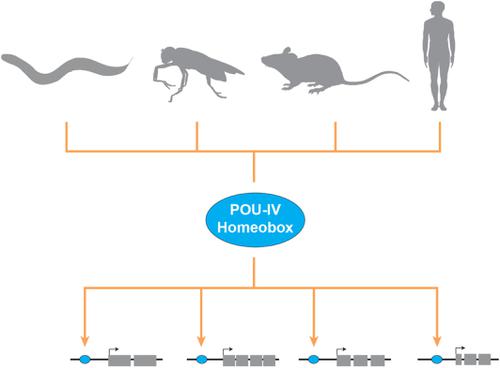当前位置:
X-MOL 学术
›
WIREs Mech. Dis.
›
论文详情
Our official English website, www.x-mol.net, welcomes your feedback! (Note: you will need to create a separate account there.)
Brn3/POU-IV-type POU homeobox genes-Paradigmatic regulators of neuronal identity across phylogeny.
WIREs Mechanisms of Disease ( IF 3.1 ) Pub Date : 2020-02-03 , DOI: 10.1002/wdev.374 Eduardo Leyva-Díaz 1 , Neda Masoudi 1 , Esther Serrano-Saiz 2 , Lori Glenwinkel 1 , Oliver Hobert 1
WIREs Mechanisms of Disease ( IF 3.1 ) Pub Date : 2020-02-03 , DOI: 10.1002/wdev.374 Eduardo Leyva-Díaz 1 , Neda Masoudi 1 , Esther Serrano-Saiz 2 , Lori Glenwinkel 1 , Oliver Hobert 1
Affiliation

|
One approach to understand the construction of complex systems is to investigate whether there are simple design principles that are commonly used in building such a system. In the context of nervous system development, one may ask whether the generation of its highly diverse sets of constituents, that is, distinct neuronal cell types, relies on genetic mechanisms that share specific common features. Specifically, are there common patterns in the function of regulatory genes across different neuron types and are those regulatory mechanisms not only used in different parts of one nervous system, but are they conserved across animal phylogeny? We address these questions here by focusing on one specific, highly conserved and well‐studied regulatory factor, the POU homeodomain transcription factor UNC‐86. Work over the last 30 years has revealed a common and paradigmatic theme of unc‐86 function throughout most of the neuron types in which Caenorhabditis elegans unc‐86 is expressed. Apart from its role in preventing lineage reiterations during development, UNC‐86 operates in combination with distinct partner proteins to initiate and maintain terminal differentiation programs, by coregulating a vast array of functionally distinct identity determinants of specific neuron types. Mouse orthologs of unc‐86, the Brn3 genes, have been shown to fulfill a similar function in initiating and maintaining neuronal identity in specific parts of the mouse brain and similar functions appear to be carried out by the sole Drosophila ortholog, Acj6. The terminal selector function of UNC‐86 in many different neuron types provides a paradigm for neuronal identity regulation across phylogeny.
中文翻译:

Brn3 / POU-IV型POU同源盒基因-跨系统发育的神经元身份的编排调节器。
了解复杂系统构造的一种方法是研究是否存在构建此类系统中常用的简单设计原理。在神经系统发育的背景下,人们可能会问,其高度多样化的成分集(即不同的神经元细胞类型)的生成是否依赖于具有特定共同特征的遗传机制。具体地说,跨不同神经元类型的调控基因功能是否存在共同的模式?这些调控机制不仅用于一种神经系统的不同部位,而且在整个动物系统发育中都是保守的吗?我们在此通过集中讨论一种特定的,高度保守且经过充分研究的调节因子POU同源域转录因子UNC-86来解决这些问题。unc-86在表达秀丽隐杆线虫unc-86的大多数神经元类型中起作用。UNC-86除了在开发过程中防止谱系重复的作用外,还与不同的伴侣蛋白结合使用,通过整合各种特定神经元类型的功能不同的身份决定因素来启动和维持终末分化程序。unc-86(Brn3基因)的小鼠直系同源物已显示出在启动和维持小鼠脑部特定部位的神经元身份方面具有相似的功能,并且类似的功能似乎由唯一的果蝇来完成。直系同源物,Acj6。UNC-86在许多不同神经元类型中的末端选择器功能为跨系统发育的神经元身份调节提供了范例。
更新日期:2020-02-03
中文翻译:

Brn3 / POU-IV型POU同源盒基因-跨系统发育的神经元身份的编排调节器。
了解复杂系统构造的一种方法是研究是否存在构建此类系统中常用的简单设计原理。在神经系统发育的背景下,人们可能会问,其高度多样化的成分集(即不同的神经元细胞类型)的生成是否依赖于具有特定共同特征的遗传机制。具体地说,跨不同神经元类型的调控基因功能是否存在共同的模式?这些调控机制不仅用于一种神经系统的不同部位,而且在整个动物系统发育中都是保守的吗?我们在此通过集中讨论一种特定的,高度保守且经过充分研究的调节因子POU同源域转录因子UNC-86来解决这些问题。unc-86在表达秀丽隐杆线虫unc-86的大多数神经元类型中起作用。UNC-86除了在开发过程中防止谱系重复的作用外,还与不同的伴侣蛋白结合使用,通过整合各种特定神经元类型的功能不同的身份决定因素来启动和维持终末分化程序。unc-86(Brn3基因)的小鼠直系同源物已显示出在启动和维持小鼠脑部特定部位的神经元身份方面具有相似的功能,并且类似的功能似乎由唯一的果蝇来完成。直系同源物,Acj6。UNC-86在许多不同神经元类型中的末端选择器功能为跨系统发育的神经元身份调节提供了范例。


























 京公网安备 11010802027423号
京公网安备 11010802027423号